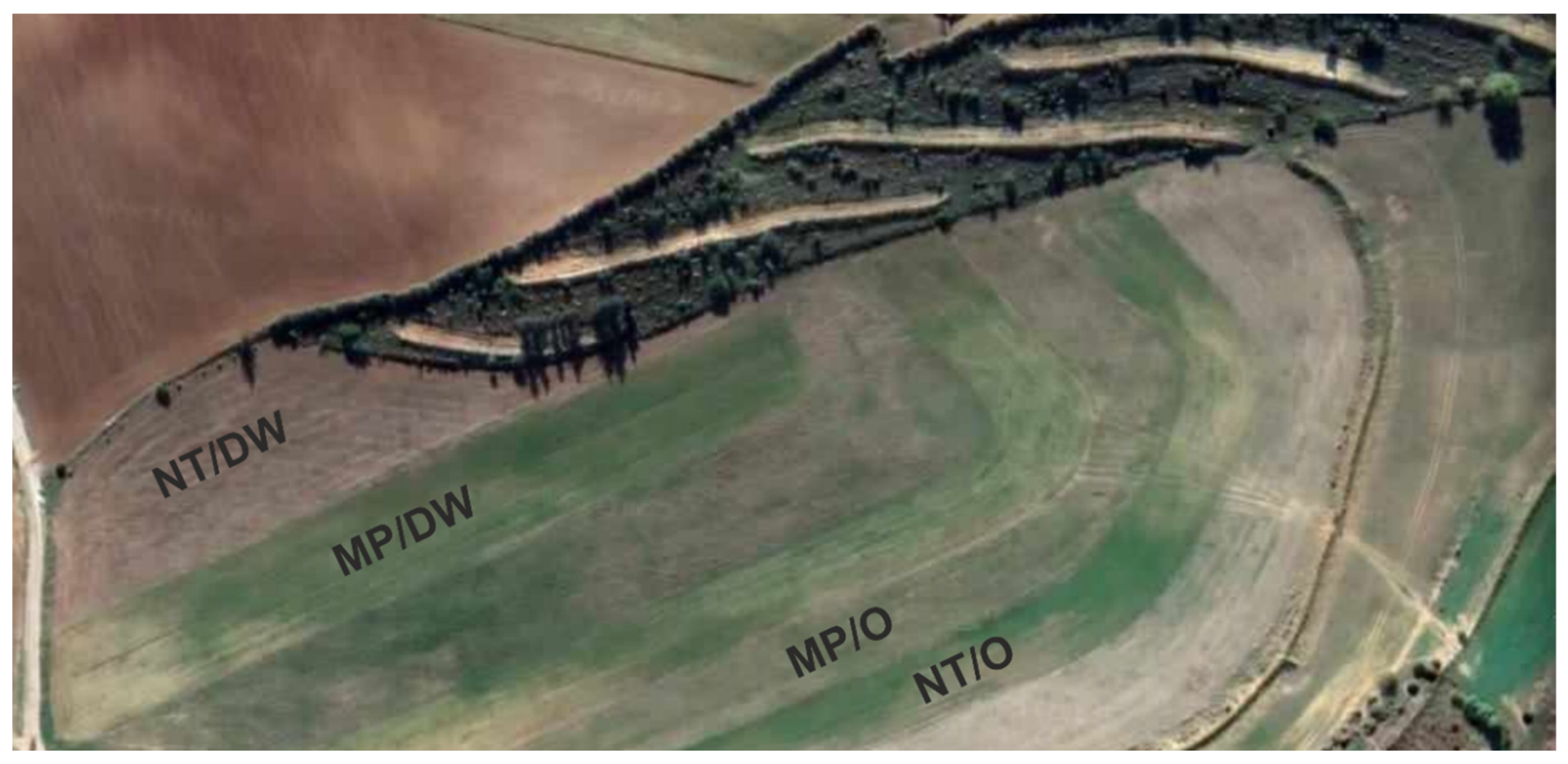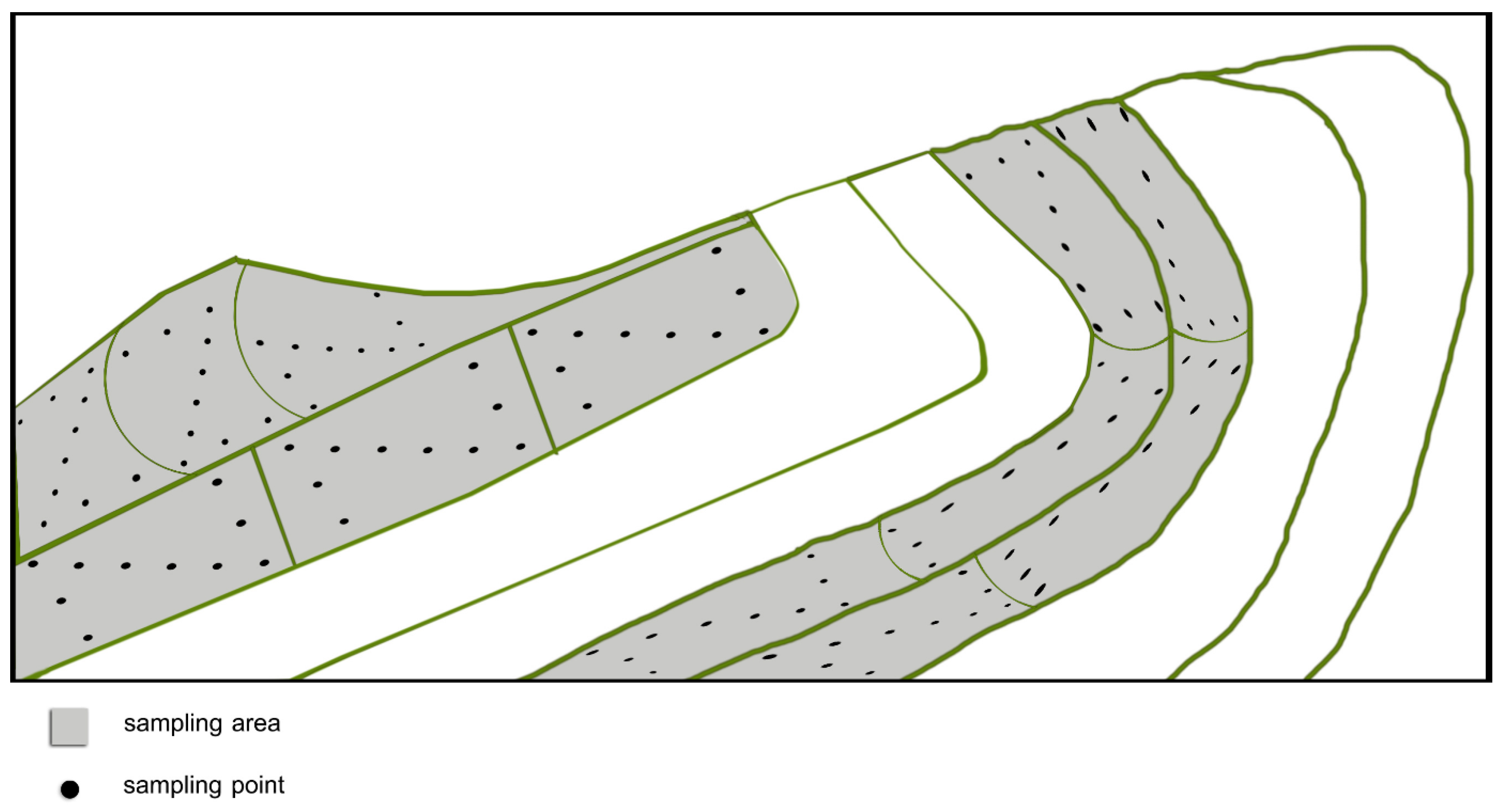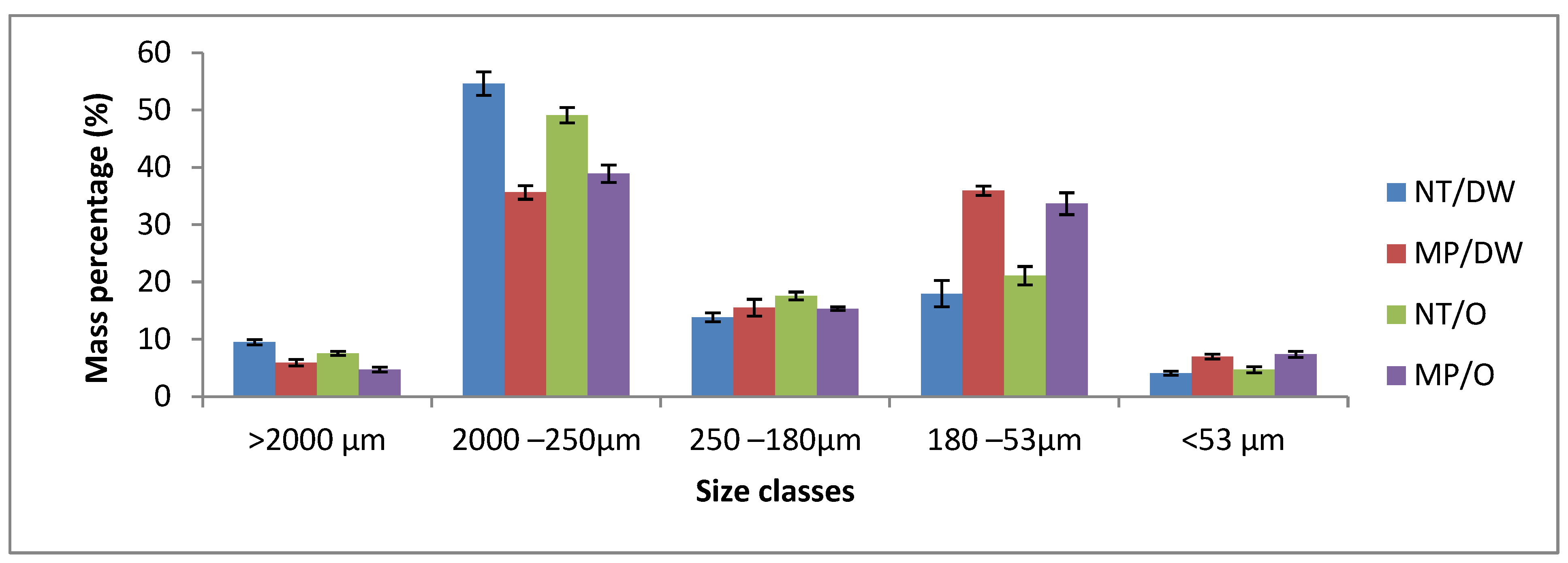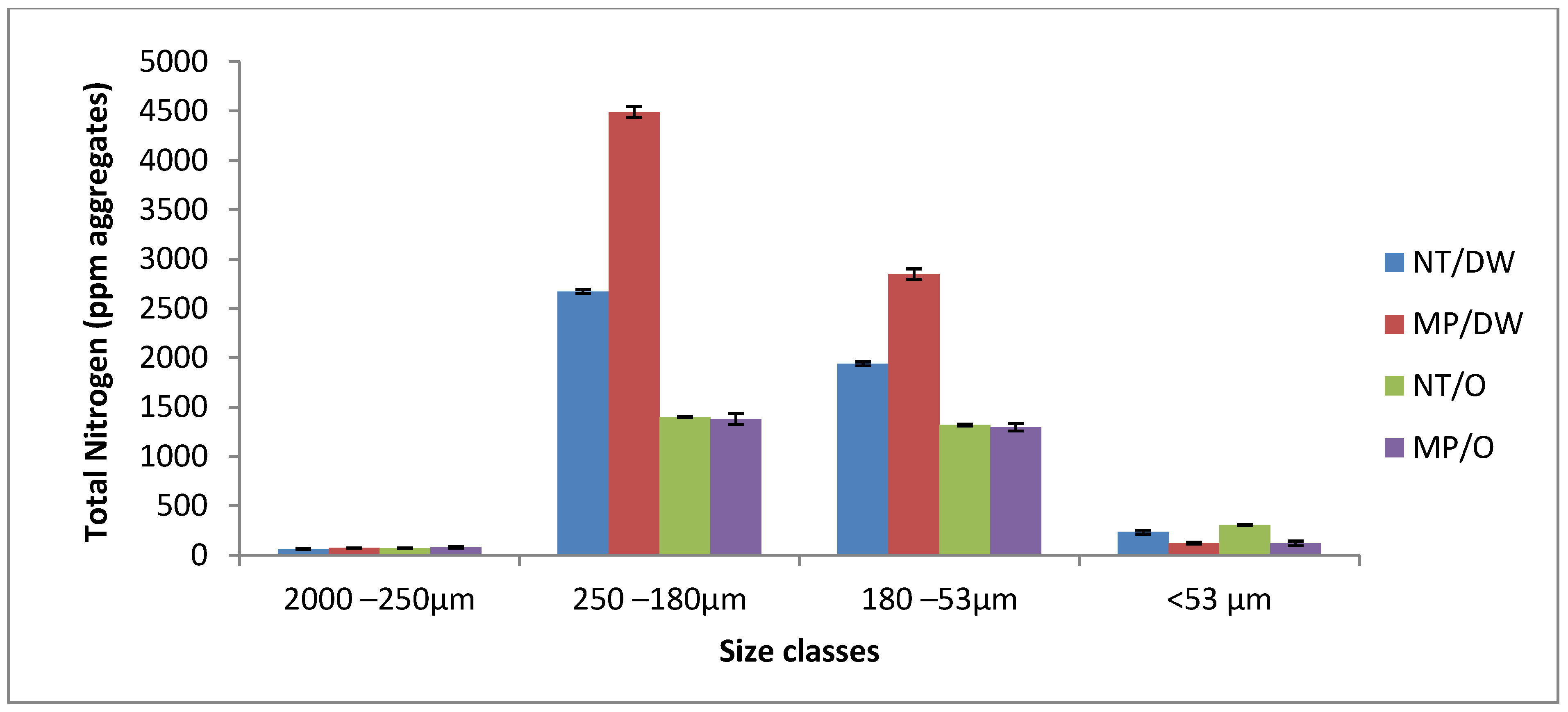Soil Aggregation and Associated Organic Carbon and Total Nitrogen in a Sandy Loam Soil under Long-Term Tillage Effects
Abstract
:1. Introduction
2. Materials and Methods
2.1. Description of Experimental Site
2.2. Chemical and Physical Analysis
- (a)
- Chemical analyses
- (b)
- Physical analysis
2.3. Statistical Data Analysis
3. Results
3.1. Distribution of the Different Classes of Aggregates
3.2. Carbon Associated with Aggregates
3.3. Total Nitrogen Associated with Aggregates
4. Discussion
5. Conclusions
Author Contributions
Funding
Data Availability Statement
Acknowledgments
Conflicts of Interest
References
- Luce, M.S.; Ziadi, N.; Rossel, R.A.V. A global-local: A new approach for local predictions of soil organic carbon content using large soil spectral libraries. Geoderma 2022, 425, 116048. [Google Scholar] [CrossRef]
- Ahmed, S.; Khan, M.; Raza, T.; Ahmad, R.; Iqbal, J. Integrated use of bio-organic and chemical fertilizer to enhance yield and nutrients content of tomato. Eurasian J. Soil Sci. 2022, 11, 126–132. [Google Scholar] [CrossRef]
- Bouajila, K. Valorisation des Résidus de Cultures et de Fumier de Ferme en Tunisie; EUE: Frankfurt, Germany, 2017; p. 177. (In French) [Google Scholar]
- Lal, R.; Hall, G.F.; Miller, F.P. Soil degradation: I-basic processes. Land Degrad. Rehabil. 1989, 1, 51–69. [Google Scholar] [CrossRef]
- Carpenedo, V.; Mielnickzuk, J. Estado de agregação equalidade de agregados de Latossolos Roxos, submetidos a diferentes sistemas de manejo. Rev. Bras. Ciênc. Solo 1990, 14, 99–105. [Google Scholar]
- Tisdall, J.M.; Oades, J.M. The effect of crop rotation on aggregation in a red-brown earth. Aust. J. Soil Res. 1980, 18, 423–434. [Google Scholar] [CrossRef]
- Chidozie, E.I.; Ifeanyi, I.F.; Johnbosco, O.M.; Onyekachi, I.A.; Anthony, C.C.; Obinna, O.M.; Gift, N.U.; George, D.; Emeka, A.S.; Raza, T.; et al. Assessment of hydraulic conductivity and soil quality of similar lithology under contrasting landuse and land cover in humid tropical Nigeria. Soil. Environ. 2019, 38, 75–80. [Google Scholar] [CrossRef]
- Ur Rehman, S.; Ijaz, S.S.; Raza, M.A.; Din, A.M.U.; Khan, K.S.; Fatima, S.; Raza, T.; Mehmood, S.; Saeed, A.; Ansar, M. Soil organic carbon sequestration and modeling under conservation tillage and cropping systems in a rainfed agriculture. Eur. J. Agron. 2023, 147, 126–840. [Google Scholar] [CrossRef]
- Tisdall, J.M.; Oades, J.M. Organic matter and water-stable aggregates in soils. J. Soil Sci. 1982, 62, 141–163. [Google Scholar] [CrossRef]
- Almaraz, J.J.; Zhou, X.; Mabood, F.; Madramootoo, C.; Rochette, P.; Ma, B.L.; Smith, D.L. Greenhouse gas fluxes associated with soybean production under two tillage systems in southwestern Quebec. Soil Tillage Res. 2009, 104, 134–139. [Google Scholar] [CrossRef]
- Mondal, S.; Chakraborty, D.; Paul, R.K.; Mondal, A.; Ladha, J.K. No-till is more of sustaining the soil than a climate change mitigation option. Agric. Ecosyst. Environ. 2023, 352, 108498. [Google Scholar] [CrossRef]
- Syed, A.; Raza, T.; Bhatti, T.T.; Eash, N.S. Climate Impacts on the agricultural sector of Pakistan: Risks and solutions. Environ. Chall. 2022, 6, 100–433. [Google Scholar] [CrossRef]
- Stevenson, F.J. Humus Chemistry: Genesis, Composition, Reactions, 2nd ed.; John Wiley & Sons: Hoboken, NJ, USA, 1994; 521p. [Google Scholar]
- Karlen, D.L.; Wollenhaupt, N.C.; Erbach, D.C.; Berry, E.C.; Swan, J.B.; Eash, N.S.; Jordahl, J.L. Crop residue effects on soil quality following 10-years of no-till corn. Soil Tillage Res. 1994, 31, 149–167. [Google Scholar] [CrossRef]
- Belmekki, M.; Mrabet, R.; Moussadek, R.; Iben Halima, O.; Boughlala, M.; El Gharous, M.; Bencharki, B. Effects of tillage and cropping systems on the structural stability and soil organic matter in semi-arid areas of Morocco. Int. J. Innov. Appl. Stud. 2013, 4, 322–333. [Google Scholar]
- Mechri, M.; Saidi, W.; Hajri, R.; Haloui, N.; Jarrahi, T.; Hanachi, M.A.; Gharbi, A.; Jedidi, N. Effet du mode de semis, du précédent cultural et de la fertilisation azotée sur l’évolution du carbone et de l’azote du sol au cours d’un cycle de production d’une culture de fenugrec (Trigonella foenum-graecum L). J. New Sci. 2016, 26, 1425–1438. [Google Scholar]
- Bouajila, K.; Ben Jeddi, F.; Sanaa, M. Valorisation des terres en pente par le sulla du nord (Hedysarum coronarium L.) en condition de semis direct et conventionnel. J. Agric. Environ. Int. Dev. 2013, 107, 33–43. [Google Scholar]
- Mechri, M.; Patil, S.B.; Saidi, W.; Hajri, R.; Jarrahi, T.; Gharbi, A.; Jedidi, N. Soil organic carbon and nitrogen status under fallow and cereal-legume species in a Tunisian semi-arid conditions. Eur. J. Earth Environ. 2016, 3, 1–13. [Google Scholar]
- Ben Jeddi, F. Hedysarum coronarium L.: Variation Génétique, Création Varietale et Utilisation dans des Rotations Tunisiennes. Ph.D. Thesis, Université de Gent Belgique, Ghent, Belgium, 2005; 216p. [Google Scholar]
- Bouajila, K. Contribution à L’étude de la Minéralisation des Résidus de Cultures et Fumier de Ferme dans des Conditions Arides Tunisiennes. Ph.D. Thesis, Institut National Agronomique de Tunisie, Tunis, Tunisia, 2016; 183p. [Google Scholar]
- Bouajila, K.; Chibani, R.; Mechri, M.; Moussa, M.; Ben Jeddi, F. Carbon and nitrogen mineralization dynamics in tow amended soils collected from the semi-arid and arid regions of Tunisia. Arab. J. Geosci. 2021, 14, 2–10. [Google Scholar] [CrossRef]
- Bouajila, K.; Hechmi, S.; Mechri, M.; Ben Jeddi, F.; Jedidi, N. Short-term effects of Sulla residues and farmyard manure amendments on soil properties: Cation exchange capacity (CEC), Base cations (BC) and Percentage Base saturation (PBS). Arab. J. Geosci. 2023, 16, 410. [Google Scholar] [CrossRef]
- Angar, H.; Ben Haj Salah, H.; Ben Hammouda, M. Semis direct et semis conventionnel en Tunisie: Les résultats agronomiques de 10 ans de comparaison. In 4. Rencontres Méditerranéennes du Semis Direct; Bouzerzour, H., Irekti, H., Vadon, B., Eds.; Ciheam: Zaragoza, Spain, 2011; pp. 53–59. [Google Scholar]
- Raza, T.; Qadir, M.F.; Khan, K.S.; Eash, N.S.; Yousuf, M.; Chatterjee, S.; Manzoor, R.; ur Rehman, S.; Oetting, J.N. Unrevealing the potential of microbes in decomposition of organic matter and release of carbon in the ecosystem. J. Environ. Manag. 2023, 344, 118529. [Google Scholar] [CrossRef]
- Chidozie, E.; Okorocha, O.; Chukwurah, M.; Taqi, R.; Muhammad, F.Q.; Uka-Onuoha, C.; Onyechere, A.; Iheka, W. Estimating land degradation neutrality (LDN) using carbon sequestration pedotransfer function on dissimilar land use and land cover in humid tropics. Soil Environ. 2021, 40, 102–109. [Google Scholar]
- Puget, P.; Chenu, C.; Alesdent, J.B. Dynamics of soil organic matter associated with particle-size fractions of water-stable aggregates. Eur. J. Soil Sci. 2000, 51, 595–605. [Google Scholar] [CrossRef]
- Lützow, M.V.; Kogel-Knabner, I.; Ekschmitt, K.; Matzner, E.; Guggenberger, G.; Marschner, B.; Flessa, H. Stabilization of organic matter in temperate soils: Mechanisms and their relevance under different soil conditions—A review. Eur. J. Soil. Sci. 2006, 57, 426–445. [Google Scholar] [CrossRef]
- Pikul, J.L.; Osborne, S.; Ellsbury, M.; Riedell, W. Particulate Organic Matter and Water-Stable Aggregation of Soil under Contrasting Management. Soil Sci. Soc. Am. J. 2007, 71, 766–776. [Google Scholar] [CrossRef]
- Yoo, G.; Yang, X.M.; Wander, M.M. Influence of soil aggregation on SOC sequestration: A preliminary model of SOC protection by aggregate dynamics. Ecol. Eng. 2011, 37, 487–495. [Google Scholar] [CrossRef]
- Ben Moussa-Machraoui, S.; Errouissi, F.; Ben-Hammouda, M.; Nouira, S. Comparative effects of conventional and no-tillage management on some soil properties under Mediterranean semi-arid conditions in northwestern Tunisia. Soil Tillage Res. 2010, 106, 247–253. [Google Scholar] [CrossRef]
- Beck, H.E.; Zimmermann, N.E.; McVicar, T.R.; Vergopolan, N.; Berg, A.; Wood, E.F. Present and future Köppen-Geiger climate classification maps at 1-km resolution. Sci. Data 2018, 5, 180–214. [Google Scholar] [CrossRef] [PubMed]
- Rouiller, J. Techniques de Laboratoire; Centre de Pédologie Biologique, Centre National de la Recherche Scientifique: Hermann, France, 1986. [Google Scholar]
- Nelson, D.W.; Sommer, L.E. Total Carbon, Organic Carbon and Organic Matter. Methods of Soil Analysis, Part 2. Chemical and Microbiological Properties, 2nd ed.; ASA-SSSA: Madison, WI, USA, 1982; pp. 579–595. [Google Scholar]
- Jones, J.B., Jr. Kjeldahl Method for Nitrogen Determination; Micro-Macro Publishing: Athens, GA, USA, 1991. [Google Scholar]
- Chen, C.; Qiu, H.; Ma, H.; Imran, S.; Raza, T.; Gao, R.; Yin, Y. Response of the subtropical forest soil N transformations to tannin acid-organic nitrogen complexes. SN J. Appl. Sci. 2020, 2, 1209. [Google Scholar] [CrossRef]
- Ma, H.; Imran, S.; Gao, R.; Yin, Y.; Raza, T. Contrasting effects of alanine and methionine on nitrogen ammonification and nitrification, and nitrous oxide emissions in subtropical forest soil. Soil Sci. Plant Nutr. 2021, 21, 2967–2979. [Google Scholar] [CrossRef]
- Ma, H.; Gao, R.; Yin, Y.; Taqi, R.; Yang, L. Dynamic of inorganic nitrogen and amino sugar to glucosamine addition in forest soils. Environ. Sci. Pollut. Res. Int. 2019, 26, 20538–20549. [Google Scholar] [CrossRef]
- Bouyoucos, G.J. Hydrometer Method Improved for Making Particle Size Analysis of Soils. J. Agron. 1962, 54, 464–465. [Google Scholar] [CrossRef]
- Messiga, A.J.; Ziadi, N.; Morel, C.; Angers, D.A.; Parent, L.É. Tillage practices of a clay loam soil affect soil aggregation and associated C and P concentrations. Geoderma 2011, 164, 225–23130. [Google Scholar] [CrossRef]
- Meijboom, F.; Hassink, J.; Noordwijk, M.V. Density Fractionations Soil organic Matter Using Silica suspensions. Soil Biol. Biochem. 1995, 27, 1109–1111. [Google Scholar] [CrossRef]
- Cambardella, C.A.; Elliott, E.T. Carbon and nitrogen dynamics of soil organic matter fractions from cultivated grassland soils. Soil Sci. Soc. Am. J. 1994, 58, 123–130. [Google Scholar] [CrossRef]
- SAS Institute. SAS/STAT Software, Release 8.2; SAS Institute: Cary, NC, USA, 2001. [Google Scholar]
- Laghrour, M.; Moussadek, R.; Mekkaoui, M.; Zouahri, A.; Dahan, R.; El Mourid, M. Impact du semis direct sur les propriétés physiques d’un sol argileux au Maroc Central (Impact of No Tillage on physical proprieties of a clay soil in Central Morocco). J. Mater. Environ. Sci. 2015, 6, 391–396. [Google Scholar]
- Denef, K.; Six, J.; Merckx, R.; Paustian, K. Carbon Sequestration in microaggregates of No-Tillage Soils with Different Clay Mineralogy. Soil Sci. Soc. Am. J. 2004, 68, 1935–1944. [Google Scholar] [CrossRef]
- Six, J.; Elliott, E.T.; Paustian, K. Soil macroaggregate turnover and microaggregate formation: A mechanism for C sequestration under notillage agriculture. Soil Biol. Biochem. 2000, 32, 2099–2103. [Google Scholar] [CrossRef]
- Dou, F.; Hons, F. Tillage and nitrogen effects on soil organic matter fractions in wheat-based systems. Soil Sci. Soc. Am. J. 2006, 70, 1896–1905. [Google Scholar] [CrossRef]
- Jiao, Y.; Whalen, J.K.; Hendershot, W.H. No-tillage and manure applications increase aggregation and improve nutrient retention in a sandy-loam soil. Geoderma 2006, 134, 24–33. [Google Scholar] [CrossRef]
- Loss, A.; Pereira, M.G.; Anjos, L.H.C.; Beutler, S.J.; Ferreira, E.P.; Silva, E.M.R. Oxidizable organic carbon fractions and soil aggregation in areas under different organic production systems in Rio de Janeiro, Brazil. Trop. Subtrop. Agroecosyst. 2011, 14, 699–708. [Google Scholar]
- Santos, C.; Loss, A.; Piccolo, M.d.C.; Girotto, E.; Ludwig, M.P.; Decarli, J.; Torres, J.L.R.; Brunetto, G. Aggregation Index and Carbon and Nitrogen Contents in Aggregates of Pasture Soils under Successive Applications of Pig Slurry in Southern Brazil. J. Agron. 2022, 12, 320. [Google Scholar] [CrossRef]
- Zotarelli, L.; Alves, B.J.R.; Urquiaga, S.; Torres, E.; Santos, H.P.D.; Paustian, K.; Boddey, R.M. SixImpact of Tillage and Crop Rotation on Aggregate-Associated Carbon in Two Oxisols. Soil Sci. Soc. Am. J. 2005, 69, 482–491. [Google Scholar] [CrossRef]
- Kumari, M.; Chakraborty, D.; Gathala, M.K.; Pathak, H.; Dwivedi, B.S.; Tomar, R.K.; Garg, R.N.; Singh, R.; Ladha, J.K. Soil Aggregation and Associated Organic Carbon Fractions as Affected by Tillage in a Rice-Wheat Rotation in North India. Soil Sci. Soc. Am. J. 2011, 75, 560–567. [Google Scholar] [CrossRef]
- Ma, H.; Tecimen, H.B.; Ma, F.; Imran, S.; Gao, R.; Yin, Y.; Raza, T.; Sun, J. Different responses of soil nitrogen to combined addition of labile carbon sources with fresh versus decomposed litter. J. Plant Nutr. Soil Sci. 2022, 185, 232–242. [Google Scholar] [CrossRef]
- Zotarelli, L.; Scholberg, J.M.; Dukes, M.D.; Muñoz-Carpena, R. Monitoring of nitrate leaching in sandy soils. J. Environ. Qual. 2007, 36, 953–962. [Google Scholar] [CrossRef] [PubMed]
- Angers, D.A.; Recous, S. Decomposition of wheat straw and rye residues as affected by particle size. Plant Soil. 1998, 189, 197–203. [Google Scholar] [CrossRef]
- Raza, T.; Abbas, M.; Amna; Imran, S.; Khan, M.Y.; Rebi, A.; Rafie-Rad, Z.; Eash, N.S. Impact of silicon on plant nutrition and significance of silicon mobilizing bacteria in agronomic practices. Silicon 2023, 15, 3797–3817. [Google Scholar] [CrossRef]





| Cropping Season | 2000/2001 | 2001/2002 | 2002/2003 | 2003/2004 | 2004/2005 | 2005/2006 | 2006/2007 | 2007/2008 | 2008/2009 |
|---|---|---|---|---|---|---|---|---|---|
| Precipitation (mm) | 388.7 | 281.9 | 585.0 | 610.0 | 468.6 | 435.6 | 461.6 | 490.0 | 929 |
| Parameters | Durum Wheat/NT | Durum Wheat/MP | Oat/NT | Oat/MP |
|---|---|---|---|---|
| Sand (%) | 78.45 | |||
| Silt (%) | 11.1 | |||
| Clay (%) | 10.95 | |||
| Textural class | Sandy-Loam | |||
| soil pH | 7.04 ± 0.04 | 7.23 ± 0.09 | 7.51 ± 0.06 | 7.68 ± 0.16 |
| Organic carbon (%) | 1.22 ± 0.07 | 0.96 ± 0.07 | 1.16 ± 0.07 | 0.91 ± 0.05 |
| C/N ratio | 12.89 ± 1.51 | 13.71 ± 1.72 | 13.18 ± 0.88 | 15.34 ± 0.15 |
| Total nitrogen (%) | 0.0946 ± 0.004 | 0.070 ± 0.002 | 0.088 ± 0.002 | 0.0593 ± 0.002 |
| N-NO3 (mg kg−1) | 3.66 ± 0.23 | 1.61 ± 0.20 | 3.86 ±0.09 | 1.63 ± 0.13 |
| N-NH4 (mg kg−1) | 7.30 ± 0.10 | 5.81 ± 0.56 | 11.43 ± 0.25 | 4.47 ± 0.49 |
| Phosphorus (mg kg−1) | 74.12 ± 3.88 | 67.38 ± 3.35 | 64.32 ± 3.21 | 45.74 ± 2.12 |
| Potassium (mg kg−1) | 195.24 ± 4.55 | 153.0 ± 11.69 | 137.57 ± 9.51 | 99.08 ± 20.85 |
| Factors | >2000 µm | 2000–250 µm | 250–180 µm | 180–53 µm | <53 µm |
|---|---|---|---|---|---|
| PC | 0.0003 | ns | 0.0096 | ns | ns |
| TM | <0.0001 | <0.0001 | ns | <0.0001 | <0.0001 |
| PC × TM | ns | 0.0012 | 0.0054 | 0.0280 | ns |
| Factors | >2000 µm | 2000–250 µm | 250–180 µm | 180–53 µm | <53 µm | |
|---|---|---|---|---|---|---|
| PC | DW | 7.70 ± 2.02 a | 45.13 ± 10.51 a | 14.68 ± 1.39 a | 26.95 ± 9.96 a | 5.53 ± 1.64 a |
| O | 6.13 ± 1.57 b | 44.00 ± 5.72 a | 16.45 ± 1.31 b | 27.39 ± 7.06 a | 6.03 ± 1.53 a | |
| TM | NT | 8.52 ± 1.13 a | 51.87 ± 3.39 a | 15.70 ± 2.14 a | 19.53 ± 2.47 b | 4.38 ± 0.53 b |
| MP | 5.32 ± 0.77 b | 37.27 ± 2.16 b | 15.43 ± 0.94 a | 34.80 ± 1.80 a | 7.18 ± 0.47 a |
| Factors | 2000–250 µm | 250–180 µm | 180–53 µm | <53 µm | 2000–250 µm | 250–180 µm | 180–53 µm | <53 µm |
|---|---|---|---|---|---|---|---|---|
| C | N | |||||||
| PC | <0.0001 | <0.0001 | ns | <0.0001 | ns | <0.0001 | <0.0001 | 0.0075 |
| TM | <0.0001 | <0.0001 | <0.0001 | <0.0001 | 0.0039 | <0.0001 | <0.0001 | <0.0001 |
| PC × TM | <0.0001 | <0.0001 | <0.0001 | <0.0001 | ns | <0.0001 | <0.0001 | 0.0044 |
| Factors | 2000–250 µm | 250–180 µm | 180–53 µm | <53 µm | 2000–250 µm | 250–180 µm | 180–53 µm | <53 µm | |
|---|---|---|---|---|---|---|---|---|---|
| C (%) | N (ppm) | ||||||||
| PC | DW | 1.05 ± 0.18 a | 0.79 ± 0.2 b | 0.90 ± 0.37 b | 1.64 ± 0.03 a | 67.17 ± 6.47 a | 3580.83 ± 996.6 a | 2391.67 ± 449.7 a | 177.77 ± 62.5 b |
| O | 0.82 ± 0.32 b | 0.96 ± 0.36 a | 0.94 ± 0.27 a | 1.44 ± 0.4 b | 72.50 ± 6.8 a | 1388.50 ± 37.2 b | 1307.67 ± 27.5 b | 211.67 ± 102.9 a | |
| TM | NT | 1.23 ± 0.09 a | 1.13 ± 0.17 a | 1.15 ± 0.17 a | 1.74 ± 0.08 a | 64.92 ± 4.7 b | 2035.17 ± 697.3 b | 1627.50 ± 338.9 b | 269.00 ± 41.1 a |
| MP | 0.64 ± 0.05 b | 0.61 ± 0.02 b | 0.69 ± 0.07 b | 1.340.2 ± 0.29 b | 74.75 ± 4.9 a | 2934.17 ± 1705 a | 2071.83 ± 849.8 a | 120.43 ± 16.5 b | |
Disclaimer/Publisher’s Note: The statements, opinions and data contained in all publications are solely those of the individual author(s) and contributor(s) and not of MDPI and/or the editor(s). MDPI and/or the editor(s) disclaim responsibility for any injury to people or property resulting from any ideas, methods, instructions or products referred to in the content. |
© 2023 by the authors. Licensee MDPI, Basel, Switzerland. This article is an open access article distributed under the terms and conditions of the Creative Commons Attribution (CC BY) license (https://creativecommons.org/licenses/by/4.0/).
Share and Cite
Mechri, M.; Bouajila, K.; Ziadi, N.; Raza, T.; Beltayef, H.; Eash, N.S.; Jedidi, N.; Gharbi, A.; Hashem, A.; Abd_Allah, E.F. Soil Aggregation and Associated Organic Carbon and Total Nitrogen in a Sandy Loam Soil under Long-Term Tillage Effects. Agronomy 2023, 13, 2520. https://doi.org/10.3390/agronomy13102520
Mechri M, Bouajila K, Ziadi N, Raza T, Beltayef H, Eash NS, Jedidi N, Gharbi A, Hashem A, Abd_Allah EF. Soil Aggregation and Associated Organic Carbon and Total Nitrogen in a Sandy Loam Soil under Long-Term Tillage Effects. Agronomy. 2023; 13(10):2520. https://doi.org/10.3390/agronomy13102520
Chicago/Turabian StyleMechri, Mouna, Khedija Bouajila, Noura Ziadi, Taqi Raza, Hayet Beltayef, Neal S. Eash, Naceur Jedidi, Azaiez Gharbi, Abeer Hashem, and Elsayed Fathi Abd_Allah. 2023. "Soil Aggregation and Associated Organic Carbon and Total Nitrogen in a Sandy Loam Soil under Long-Term Tillage Effects" Agronomy 13, no. 10: 2520. https://doi.org/10.3390/agronomy13102520






